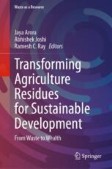Search
Search Results
-
Microbial Production of Sugar Alcohols
Sugar alcohols, also known as polyols, are organic sugar derivatives and have the general formula HOCH2(CHOH)nCH2OH. These are acyclic hydrogenated...
-
Production of Ethanol from Plant Biomass
The demand for bioethanol has been steadily growing over fossil fuels due to lower greenhouse gas emissions, improved energy security, and rural...
-
Life Cycle Analysis on Production of Renewable Chemicals, Materials, and Energy from Oil Palm Wastes
Management of the oil palm residues is one of the most demanding hitches in the industry of palm oil. Palm oil is the main product while the most...
-
Harvesting Systems for Short Rotation Coppice Crops Influence Cost, Performance, and Biomass Quality
Harvesting in short rotation coppice (SRC) systems occurs every 2–4 years with recommendations focusing on dormant season harvest. Because harvesting...
-
Enzymatic Hydrolysis of Lignocellulosic Biomass at High Solids Loading
The conversion of lignocellulosic materials into reducing sugar needs an enzymatic hydrolysis step known as saccharification and is a key...
-
Dependence of Enzymatic Saccharification on the Type of Biomass and Pretreatment
Variety of agricultural crops and other forest residues form an important lignocellulosic biomass feedstock for biorefineries. However, these...
-
Biomass Attributes and Attribute Modifications Affecting Systems and Methods to Separate and Fractionate
Chemical and physical heterogeneity in biomass feedstocks such as agricultural or forestry residues is due to substantial differences in plant tissue...
-
Biofuels from Forest Logging Residues
Forests are very large carbon sinks storing the highest density of biomass carbon and thus the biomass feedstock, necessary for biofuel production....
-
Strategies for Overcoming the Inhibition of Cellulose Hydrolysis
Lignocellulosic biomass biorefinery allows the conversion of the most abundant biomass into cascades of products. Cellulose present in the...
-
Organosolv Pretreatment of Lignocellulosic Biomass
The utilization of organic solvents or their aqueous solutions in the selective fractionation of biomass feedstocks, commonly referred to as...
-
Mitigation of Industrial Flue Gases and Wastewaters Through Algal Biomass Cultivation: Processes and Perspectives
Global population growth, increase in product manufacturing facilities, and increasing CO2 emissions from enterprises have led to global warming....
-
GH2 Networks: Production, Supply Chain, and Storage
Climate changes and the urgent need for clean energy in the international community and the acceleration of the improvement of the green economy add...
-
Environmental Footprints, Economics, and Sustainability of Solar Thermal Desalination Systems
Solar energy is freely available in nature. However, in order to utilize it for desalination or wastewater treatment proper systems needs to be...
-
Stepped Solar Thermal Desalination Systems
Reduction of basin water depth is a key parameter to improve the distillate production rate of solar stills. Minimal basin water depth indicates...
-
Tubular Solar Thermal Desalination Systems
Advantage of tubular solar thermal desalination system is its higher condensing surface area compared to other systems. Moreover, it can be...
-
Multi-effect Tubular Solar Thermal Desalination Systems
The performance and distillate productivity of tubular solar desalination system can be enhanced by recovering and reusing its latent heat of...
-
Tilted Solar Thermal Desalination Systems
Tilted solar thermal desalination systems are relatively high productive than basin type systems. Moreover, its tilt angle can be adjusted as per...
-
Solar Thermal Wastewater Treatment Systems
Wastewaters that are generally dumped into water bodies without any pre-treatment are mainly RO (reverse osmosis) reject and domestic sewage water....
-
Vertical Diffusion Solar Thermal Desalination Systems
The productivity of solar stills can be enhanced significantly by reducing the gap between the evaporating and condensing surface. However, this is...
-
Sustainable Packaging Solution from Agriculture Waste: Production of Bioplastic, Biocomposite, Biopolymer
In recent decades, the depletion of natural resources and growing environmental concern has increased the desire to find innovative methods to...
